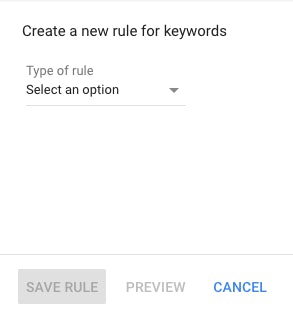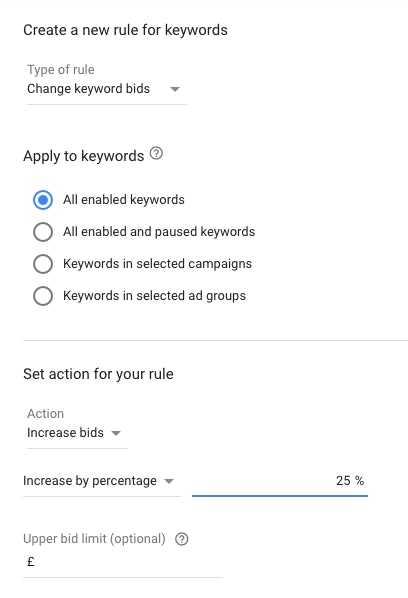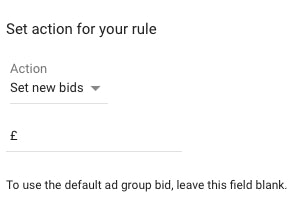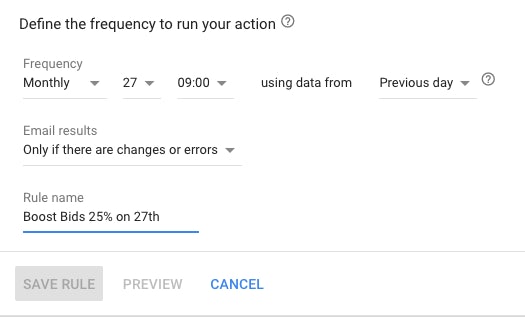The end of the month sees a spike in spending for many businesses and now thanks to automated rules, your Google Ads campaigns can capitalise on it. Once you’ve set up an automated rule to raise your Max CPC bids towards the end of the month and another to drop them down again at the start of the next month, you can rest assured that you’ll be capturing extra traffic with money in their pockets.
How to set up the rules
Once you’ve logged into Google Ads, click Tools and under Bulk Options, click Rules.
You should see a big blue plus button on the left-hand side of your screen. Click that and then “Keyword Rules”. You’ll then be presented with a screen like the one below.

Select “Change keyword bids” from the drop down menu and a screen similar to the following will appear.

Now you can select which keywords you’d like to increase bids on around payday and also how much you’d like to boost them by.
Initially, the “Set action for your rule” section will look like this:

From here, all you have to do is select “Increase bids” and then “Increase bids by percentage” in the drop down menus presented. You can now enter which percentage you’d like to boost your bids by.
Scheduling the rules
Don’t forget to actually set the rule to run. Use the scheduling section below to set up the day of the month and the time that you want it to run each month.

Click “Save Rule” and you’re done. It’s as easy as that!
What goes up must come down
It’s important to remember to bring your bids down after the payday spending spree has stopped. Although you could manually reduce your bids to previous levels, you can just as easily set up another automated rule to bring everything back down to where it was. Simply follow the instruction above to set up another rule, but this time select “Decrease bids”, “Decrease bids by percentage” and then set it up to run on a day at the start of the month instead of the end.
A word of warning
If you originally put your bids up by a percentage, use extreme caution when putting them back down again. Thanks to the wonderful world of mathematics, it’s very easy to do it incorrectly.
If you put all of your bids up by 25%, you just drop them all by 25% afterwards, right? Wrong. Let me explain.
Let’s say your bid was initially £1.00 and on the 27th of the month you boosted your bid by 25%. You guessed it – your bid is now £1.25. However, if you then reduced the bid by 25% on the 3rd of next month, your bid would then be £0.94, six pence lower than when you started.
What is this madness? Well, it’s all down to the fact that the bid is being reduced by 25% of the higher bid, not the original bid.
Here’s that maths again in slow motion:
Increase £1.00 bid by 25%
25% of £1.00 = £0.25
£1.00 + £0.25 = £1.25
Decrease £1.25 bid by 25%
25% of £1.25 = £0.3125 = rounded to £0.31
£1.25 – £0.31 = £0.94
Fortunately for you, there’s some pretty simple sums you can do to work out what percentage you need to reduce things.
1 – (100/100+percentage increase)
Didn’t quite follow that? Let’s use our 25% example from before.
25 is our percentage increase, so to get things back to normal we need to reduce bids by 1 – (100/125) = 0.20.
Increase £1.00 bid by 25%
25% of £1.00 = £0.25
£1.00 + £0.25 = £1.25
Decrease £1.25 bid by 20%
20% of £1.25 = £0.25
£1.25 – £0.25 = £1.00
And voilà – we’re back to where we were.
What about rounding?
Google will round to the nearest penny, so you might not always get everything bang on what you had before, but you’ll be close enough.
But what if everyone else does this?
You might be asking yourself “What if my competitors also do this?” Good point. After all, if you all increase your bids by 20%, you’ll all be in the same positions, but thanks to Google Ads’ auction system, you’ll be paying more for the privilege.
Here’s my counterargument:
- If you don’t increase your bid and your competitors do, you’ll fall behind in position. Do you really want to be left behind around payday?
- Even if your competitors know how to do this, that doesn’t mean that they will do it. Knowledge isn’t power, execution is.
- You and your competitors are unlikely to choose the same bid increase. If your bid adjustment puts your bid higher than theirs, you stand a much better chance of leapfrogging their position (or holding onto your current one).
Embrace the automation
Although this is a super simple strategy, it has the ability to generate more revenue for our clients with just a few minutes of work.
At Impression, we use automation to free up time for the tasks that need a human touch. Learn more about our scientific approach to paid search advertising here.



